Business Process Reengineering in Human Resource Management
Info: 10287 words (41 pages) Dissertation
Published: 1st Oct 2021
Tagged: Human Resources
Table of Contents
1. Introduction to BPR......3-5
2. Taco Bell......5-7
3. Honeywell Asia Pacific Inc......8-12
4. Mahindra and Mahindra Limited......13-15
5. FORD......16-17
6. ICICI BANK......18-19
7. ASSESSING READINESS FOR BUSINESS PROCESS REENGINEERING......20-25
8. Business process reengineering: critical success factors in higher education”......26-30
9. Implementation of Business Process Reengineering in Human Resource Management......31-35
10. References......36
Introduction Business Process Reengineering
Originally pioneered in the early 1990s, business process reengineering involves the radical redesign of core business processes to achieve greater improvements in productivity, time cycle and quality. In Business Process Reengineering, companies start from beginning and redesign the existing processes to deliver more value to the customer.
Benefits of Business process reengineering trend
- Reduces cost and cycle time
- Helps in improving quality
Business Process Reengineering consists of five major steps. Managers should focus on:
- Refocus company values according to the needs of customer.
- Redesigning of core processes.
- Reorganize the business into cross-functional teams with end-to-end responsibility.
- Rethink basic organizational and people issues.
- Improve business processes of the organization.
Reengineering Work: Don’t Automate, Obliterate, 1990
In 1990 Micheal Hammer published the article in which he stated that the manager’s main issue is to wipe out those processes which are not adding any value to the product.
Hammer’s claim was simple: Most of the work being done does not add any value for customers, and this work should be removed, not accelerated through automation. Companies should work on satisfying customer needs and decreasing cost structure. Untill 1993, 60% of fortune companies had either implemented this policy or were planning to implement it even after it having a disadvantage of reducing work force.
Development after 1995
After publication by some critiques in 1995 & 1996 the reengineering trend decreased. But after then it became a widely accepted technique but its way of implementation had changed.
Positive and negative aspects of Business Process Reengineering
A trend can result into success or failure depending on conditions it is implemented in.
Positive Aspects of BPR
- Business process reengineering is performed in such a way that it always provides agility to the business so that the business can overcome the previous barriers and function smoothly compared to before.
- Reduced costs that are associated to the business process execution
- Customer needs are made the priority and this vision is used to appropriately direct business practices
- There are cost advantages to be achieved that help the organization become more competitive in its industry
- A strategic view of all operational processes is taken with relevant questions being asked about the established way of work and how it can be developed over the long term into more efficient business practices
- There is a willingness to look beyond tasks and traditional functional boundaries with focused outcomes. Through this, entire processes can be eliminated or amalgamated into fewer but more relevant and powerful processes throughout the organization
- There is a real desire to simplify the way of work by objectively assessing all activities and tasks and eliminating any that add less value and more complexity.
Disadvantage
A. Resistance to change BPR require adjustment, and the adjustment is the overall of the entire organization. Not all employees are psychologically prepared for the changes in the company. There are employees who are unwilling and resist to adjustment because of fear, mistrust, and loss of job security. The unwillingness to change by the employee, will resulting the risk of failure in BPR. Some workers may not be able to fully adapt the changes, and those employees that receive and assigned to different job role can become overwhelmed. Other workers become unproductive if the main function is removed and as part of a process changes and redesign Management must provide support and guidance during BPR. If the top management fail to guide and assist workers and set an example during the BPR process may lead to failure and other negative consequences.
B. Higher Demands to the Workers Empowering the workers is an unavoidable approach in a re-engineered process. Therefore the companies which hire new workers have to consider additional criteria in their hiring .This might be more complicated to find the right people for one specific job. The worker has to be a kind of “All-rounder” which can perform several jobs.
Advantage
a. Satisfaction-A big advantage of reengineering is that the work becomes more satisfying because the workers get a greater sense of completion, closure, and accomplishment from their jobs. BPR revolves around customer needs and helps to give an appropriate focus to the business to improve the satisfaction of customer, employee and supplier.
b. Solidarity to the Company – According to Hammer and Champy 2001, the re-engineered process will contribute to company in focusing matter that is the company can spend more time on value adding work and less on process that adds no value to the product.
c. Maintain competitive advantage – Each company will have their own competitive advantage that able to outperform their rivals, With the BPR implemented, the value added activity will be given more time.
Taco Bell – A Reengineered Come Back
In 1983, Taco Bell limited themselves to the goal of becoming a value leader in the quick-service restaurant industry rather than the value leader for all foods for all occasions. The process of reengineering at Taco Bell involved several steps, including:
- Complete reorganization of human resources
- Dramatic redesign of operational systems
- Doing away with entire levels of management
- Creation of jobs
- Replacing area supervisors with market managers and reducing their numbers
- Eliminating district managers and promoting restaurant managers
- Reduction in the costs of everything about the business except the cost of the food and its packaging.
In short, Taco Bell followed only one rule during the entire process of reengineering-
Enhance those things that bring value to the customer and change or eliminate those that don’t.
They also changed their restaurant structure by:
- Limiting kitchen area from 70% to 30%
- Increasing the customer area from 30% to 70%
- Doubling the seating capacity in the area available
Additionally, reengineering led Taco Bell to introduce two new methodologies, namely K-Minus and TACO (Total Automation of Company Operations).
K-Minus means ‘kitchen less restaurant’, based on the nature of the company. All of their food was cooked outside the restaurant in central locations. This stemmed from the concept that food should be retailed instead of manufactured. TACO provides:
- Each restaurant with a Marketing Information System (MIS) and empowered the employees with computer know-how.
- It eliminated paper-work and allowed more time to be spent on customers. It helped keep track of sales minute by minute.
While the environment was not a factor in Taco Bell’s reengineering, it hadbenefitted through the reengineering process. The TACO program provides sophisticated MIS technology for all employees, saving thousands of hours of paperwork — and thus paper — as well as promoting self-sufficiency and reducing time spent on administration. The K-Minus program established a system where the large majority of food preparation occurs at central commissaries rather than in the restaurant, pushing 15 hours of work a day out of the restaurant, improving quality control and employee morale, reducing employee accidents and injuries, and resulting in substantial savings on utilities. The K-Minus program saves Taco Bell about $7 million a year.
Advantages of Business Process Reengineering in Taco Bell
- Taco Bell after implementing BPR increased their sales from $500 million in 1982 to $3billion in a span of 10 years.
- TACO (Total Automation of Company Operations) program of the company provided Marketing Intelligence Systems for all its employees by which there was a reduction in administration time and paper savings as the work became digital.
- The Kitchen less program was a huge success providing customers with quality control, high employee morale as well as doing large savings on utilities.
- Savings of around $7 million a year was a result of the K-Minus program.
- Taco bell now focused more on customer business processes and can spent a huge amount of time on customer look after.
- New job profiles for market managers were introduced.
- The customer seating area was approximately doubled and the kitchen area was reduced.
Disadvantages of Business Process Reengineering in Taco Bell
- The process of BPR was time consuming process.
- There was a resistance to change as complete environment was set in other way.
- Workers’ demands increased as a result they have to change the workforce.
- Many previous jobs were shuttered like the area supervisors and new were introduced which resulted in unemployment.
Honeywell Asia Pacific Inc
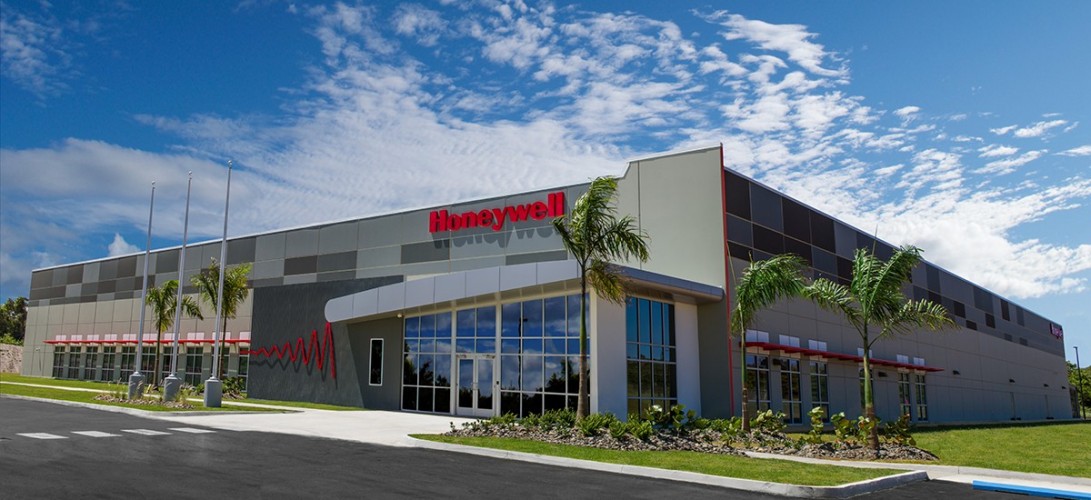
Introduction
Worldwide rivalry is driving associations to end up more Leaner and that’s just the beginning. Numerous associations have swung to business process reengineering (BPR) as a way to profoundly change the way they lead business. We consequently set out on a contextual investigation to profoundly investigate one association’s encounters with radical change to uncover how they made progress. The association we inspect is Honeywell Inc. in Phoenix, Arizona. From the information, we devise an arrangement of lessons to help other people change effectively.
Honeywell used Business Process Reengineering to:
Diminish expenses and process durations. Business Process Reengineering diminishes expenses and process durations by disposing of inefficient exercises and the workers who execute them. Group rearrangement decreases the requirement for administration layers, accelerates data stream, and wipes out blunders and correcting caused by different exchanges. Enhance quality. Business Process Reengineering enhances quality by lessening work fracture and setting up clear responsibility for Labourers pick up duty regarding their outcomes, enhances team work and can gauge their execution in view of fast criticism.
The Honeywell modern mechanization and control (IAC) specialty unit plans, makes, and designs the complex TDC 3000X group of frameworks. These frameworks empower its clients (refineries, compound plants, and paper processes the world over) to accomplish world-class process-control ability.
Issues
One issue was administration of “white spaces”. Blank areas are holes between various connections in the interior store network. Administration discovered that groups along the esteem chain for every product offering tended to sub-enhance the aggregate supply chain since they were principally centered around their own particular zones. To get the groups to think as one, the Director of Strategic Planning and Organizational Improvement approached the three group directors and disclosed to them that they were in charge of the entire product offering. Execution assessments would be in view of how the whole product offering performed. Honeywell IAC saw through experimentation that groups needed control over things that effect their execution. At the point when groups did not performed well, the reason could quite often be ascribed to absence of specialist to settle on choices where the work was really being finished. Another change that helped groups function admirably together was a difference in workplace. As of late, producing was moved to a liberally finished site. Other than being a excellent site, fabricating offices were intended to better suit a stream conspire. The stream plot was intended to encourage a “pull” framework that is activated by client orders. Transformation to an all-salaried workforce, employee strengthening, remuneration for innovativeness, and a framework see helped IAC limitlessly enhance its quality and execution for its clients. In any case, IAC administration was definitely not fulfilled.
- Process mapping : Process mapping is a device that enables one to demonstrate the stream of any business process in a graphical shape. The procedure outline one to perceive how the procedure as a matter of fact works crosswise over useful limits. It along these lines empowers all representatives to perceive how the business procedure really functions and how it can be changed to be more compelling. Process mapping additionally makes a typical dialect for managing with changes to business forms
At Honeywell, process mapping comprises of eight stages are to select process, distinguish limits, shape groups, create “as is” delineate, process durations, distinguish open doors for development, create “should be” outline, create the usage design (get affirmation before execution). The activity of the facilitator is to energize innovative thoughts from groups and guide the exertion.
- Fail safing: Come up short safing is a strategy to recognize an imperfection, break down it to comprehend its root cause, and afterward build up an answer that will keep that deformity from happening once more. Fall flat safing ensures that a procedure will be sans deformity
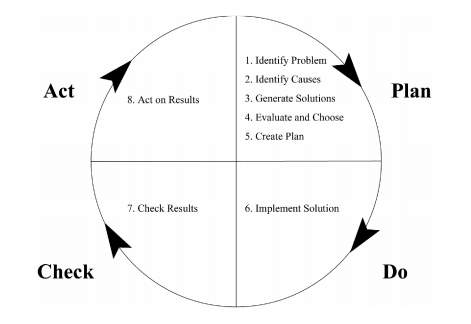
3. Collaboration : Collaboration does not happen normally. It is troublesome and complex. It takes extraordinary exertion, administration support, preparing, and a sustaining domain to make it work. Unique preparing is expected to acclimate individuals (counting administrators) with what groups are, the manner by which they work, and how they will help the organization. In the wake of preparing, labourers need to “feel” that the workplace is helpful for groups. The key is to create struggle determination aptitudes that perceive this propensity and hone these aptitudes in a non-undermining condition until a specific level of authority is come to. Much the same as joining, powerful correspondence depends vigorously on the work condition
Execution
The greatest error to execution was inside the centre administration positions. Individuals from centre administration were excessively utilized, making it impossible to being specialists in a particular range. For example, one operations administrator was the occupant master in materials stream, however he oversaw innovation, designing, and assembling individuals. He would oversee sub-ideally in light of the fact that each issue was comprehended through materials stream. He couldn’t see the cross-practical or cross-specialization nature of the issue due to his tight concentrate on materials stream. He needed to “let go” of his skill and let his kin take care of the issue as a cross-utilitarian group. It might seem like a basic change for this chief, yet it took years. Behavioural change is the most troublesome sort of progress. It requires investment and tolerance. Execution of a noteworthy change program hence requires a great deal of time to receive wanted rewards. With speedy benefits and eagerness the standard in numerous associations, execution will be the greatest obstacle to progress. Appropriation of components, similar to those utilized at Honeywell, are along these lines useless without a get ready for change and legitimate execution of that arrangement.
Lessons learned
From the contextual investigation, we built up an arrangement of general lessons. The case understanding enabled us to talk inside and out with individuals associated with big business change that should make the lessons more useful.
Lesson one: individuals are the key empowering agents of progress Business forms are extra ordinary, yet process mapping offers an exhaustive plan of the current state. The outline empowers efficient recognizable proof of chances for development. IT is perplexing, however merchants, specialists, and framework planners can make models of the framework. Interestingly, individuals are capricious. They can’t be demonstrated or ordered all around. In any case, individuals take the necessary steps and consequently should be prepared, encouraged, and supported.
Lesson two: question everything Enabling individuals to scrutinize the way things are done is basic to change. Come up short safing gives a deliberate way to deal with successfully question the status quo. Individuals are urged to scrutinize the current state.
Lesson three: individuals require a methodical procedure to delineate Process mapping is the component used to delineate comprehend complex business forms. The deliberate idea of the procedure mapping approach keeps individuals centered and goes about as a reviving point. Also, process mapping gives same platform to everybody associated with the venture.
BUSINESS PROCESS REENGINEERING AT MAHINDRA AND MAHINDRA LIMITED
During the mid 1990’s, the plants at Igatpuri and Kandivili in Maharashtra were facing problems on account of inefficiencies in manufacturing, poor productivity, long production cycle, sub-optimal output etc. The main reasons for such dismal state of affairs was due to the highly under productive workforce, unhealthy work culture, militantly organized unions and the widespread corruption that had penetrated deep into the workings at the plants facility. Till now, the management was very lenient and often crumbled under the workforce’s demands.
Chairman of the Mahindra Group, Keshub Mahindra took seriousness of the problem that was widespread at the plants facility. He tried addressing the seriousness of the issue by sacking people who indulged in the corrupt malpractices. Mahindra and Mahindra implemented the Voluntary Retirement Schemes as a way of reducing the workforce but the unions refused such proposals and didn’t cooperate.
Mahindra and Mahindra considered the implementation of the Business Process Reengineering program for the whole organization with speedy implementation of the BPR program at its manufacturing facilities of Igatpuri and Kandivili. The BPR program was developed and first implemented at the Igatpuri plant with the help of Lucas Engineering Systems (UK based company).
Mahindra and Mahindra faced resistance from the unions in the face of implementation of such a program.
IMPLEMENATION OF BPR
In 1994, a major restructuring program was started as part of implementation of Business process Engineering.
STAGE 1: RESTRUCTURING
Under this, the Mahindra and Mahindra introduced the new model in which the regrouping of six distinct clusters of related businesses was undertaken each of which was headed by a President of the unit. The six clusters were :
- Infrastructure
- Trade and Financial services
- Telecommunication
- Automotive components
- Automotive Divisions
- Farm Equipment divisions (which make tractors and farm implements)
The whole purpose of the divisions into 6 different clusters was done to develop a map and to give direction to the growth of the different business segments.
STAGE 2: REENGINEERING THE WORKING PROCESS AND LAYOUT
- Cellular Manufacturing: Here it deals with multitasking through the multi-machine manning and through the reduction of the non productive and redundant activities.
- Implementation of the Total Quality Management (TQM) and KAIZAN.
- Concurrent Engineering that is through formation of cross functional teams dealing in Improvement of the existing product, Up gradation and modification of the existing product and finally through development of the new product.
RESULTS OF THE BPR PROGRAM
When Mahindra and Mahindra’s workforce resisted the idea of the BPR program, and as the senior staff took over and began to work on shopfloor, the benefits of the BPR set in:
- After implementing BPR, 100 officers produced over 35 engines per day as against 70 engines produced by 1200 workers before implementation of the BPR program.
- At the Igatpuri plant, the no. of employees declined by around 400, but the productivity increased by 125 engines per day. Hence it was clearly visible the increase in the efficiency which was a problem prior to implementation of the BPR.
- Workers ended the strike after five long months and began working at the facility in return for a wake hike of 30%.
- At the Nasik plant, the productivity improvements went up as high as 125 percent.
- Plants capacity utilization improved from 45 percent to 55 percent.
- Value addition per employee increased by around 53 percent (from 0.3 million to 0.46 million).
The factors attributable to the successful implementation of the BPR were as follows:
- The barriers or the obstacles were correctly identified and dealt with.
- The fact that the cultural resistance of the workforce was being effectively countered.
- The formation of the separate teams each headed by a president
- Personal involvement of the Top Management.
Ford’s accounts payable case study
In the early 1980’s, Ford, like many other American corporations, was exploring ways to reduce overhead and administrative costs. One of the places Ford believed it could lower cost was in its account department could have lower costs, the organization which paid the bills submitted by Ford suppliers. At that time, accounts payable in North America alone employed over 500 people. Ford management thought that the existing process can be automated using computers to reduce headcount by 20%. Ford was enthusiastic about its plan in order to intensify accounts payable until he looked at Mazda. While Ford was expecting a 400-person division, Mazda payable organization was a total of 5 people.
The difference was in the total number of numbers and Ford had even modified Mazda’s smaller size, the organization that was payable to the accounts was five times. Ford managers set up their objective: the accounts payable would only be made but only one hundred more than hundreds of fewer clerks. It is then set out to achieve it. Initially, managers inspected the existing system. The accounts payable cannot be re-engineered, because it is not a process, but a division. A “payable process” was not the Ford redesign process but a “supply”. Ford’s old part acquisitions process was relatively traditional.
He started purchasing a purchase order to a seller, and a copy going to accounts payable. When the goods came to Ford, filling “material control” was a form that described the goods and sent it to accounts payable. Meanwhile, the seller sends accounts payable an invoice. At this point, the payable account was to match the purchase order with the acceptance document and the invoice. If all three of these documents have failed, the department made a payment. If they were any discrepancy between purchasing orders, receiving documents and the payment invoice. In the case of these inconsistencies, the department had a great deal of time to verify them. In these cases, a paying clerk would investigate the inconsistency, payment of payment, generating documents and all in all gums up to the works
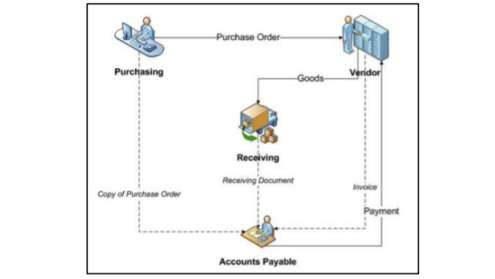
Ford accounts payable process - Before business process reengineering
One way to improve things was determined to be a barrier to the inconsistencies in the first place. In order to achieve this, Ford introduced “uninterrupted processing” in practice. Now, payable clerks do not have to be able to match a purchase order with the invoice to receive a document, mainly because the new process eliminates the invoice completely. Now, in this new process, when a purchaser in the department bought a purchase order to a seller, the buyer will put the order into an online database at the same time. Vendors like to send the goods to relevant control. When they arrive responsible person in the relevant control check a computer terminal to see the shipment obtained matches with the outstanding purchase order in the database. There are two chances: It does or does not. If it does, the clerk accepts the goods “relevant control” and presses a button on the keyboard that tells the database that the goods came.
The receipt of the goods are now saved in the database, and the computer will automatically issue and send a cheque to the vendor at the appropriate time. On the other hand, if the goods do not comply with the outstanding purchase order in the database, the clerk will refuse the “material control” of the shipment and return it to the seller. As seen from the application, Ford made a radical change and a great improvement. In this way, Ford managed to achieve a 75% reduction in a count, and not the 20% that it would have gotten through traditional program. Also, since there is no proportionality between the financial record and the physical record, material control is easier and financial information is more accurate and accurate.
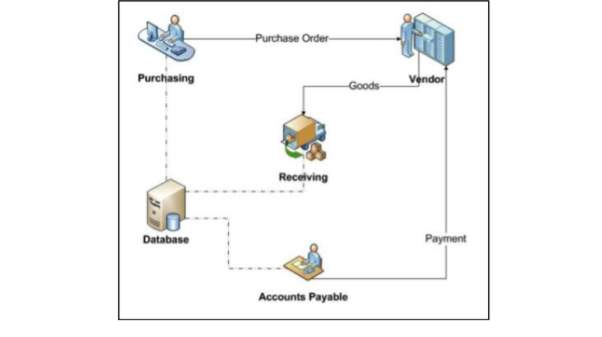
Ford accounts payable process- After business process reengineering
ICICI BANK
ICICI Bank (formerly Industrial Credit and Investment Corporation of India) is a major banking and financial services organization in India. It is the 4th largest bank in India and the largest private sector bank in India by market capitalization. The bank also has a network of 1,700+branches and about 4,721 ATMs in India and presence in 19 countries, as well as some 24 million customers.
ICICI Bank is one of the Big Four Banks of India, along with State Bank of India, Axis Bank and HDFC Bank its main competitors.
Reasons for Implementing BPR
- BPR was implemented in ICICI Bank in year 2000 and later when anytime, anywhere banking came to our country, ICICI Bank had to move away from the branch-centric model and make its services available nationwide. The solution was to centralize its applications.
- Legacy systems: The traditional systems at ICICI Bank were very centric to the branch. ICICI realized the importance of offering nationwide banking but this would be possible only by havinga centralized data repository.
Teams Involved
Following teams were involved in the BPR process of ICICI bank:
Infosys was one of technology partner for ICICI Bank which gave the assistance to implement Finacle for handling all the banking activities. Finacle is one of the most popularly used software in the banking system.
Bill Desk was the company which facilitated online payments for ICICI and it was also involved in the Business Process Reengineering of the bank.
SYBASE was the company which provided database management systems to ICICI bank and was also involved in the BPR process of ICICI.
SAS is the company which provided the company with Management Information System and analytical tools to handle consumer data.
Solutions through Business Process Reengineering
SUPPORTING TOOLS AND TECHNIQUES:
- Finacle – a core banking and universal banking solution from Infosys
- The network being used in ICICI bank at those times followed a hub and spoke architecture—a mix of VSATs (Very small aperture terminal), leased lines, ISDN and radio links. It had around 800 leased lines, about 600 VSATs, approximately 800 ISDN lines and multiple 34 Mbps lines.
Results
The scalable and open systems based architecture, enabled Finacle to successfully manage the resultant increase in transaction levels from 400,000 transactions a day in 2000 to nearly 2.1 million by 2005 with an associated growth in peak volumes by 5.5times. With Finacle, the bank’s ability to process cheques increased to 0.27 million per day and was able to manage 7000 concurrent users.
ASSESSING READINESS FOR BUSINESS PROCESS REENGINEERING
Introduction
Since 1990’s, the organizations have been focusing much upon the more flexible, coordinated processes in the businesses. In order to remain globally competitive, they have been focusing on the business processes that produce output that should produce value addition for the customers.
Business process reengineering is a strategy wherein the business processes which are core to a business performance are redesigned in such a manner so that it leads to cost effectiveness, productivity improvements, and quality enhancements. Business process reengineering has gained importance primarily owing to the fact that it facilitates the integration of the processes across two organizations and also it is necessary for the back and front office operations.
BPR is a time consuming and an expensive affair besides being risky too. This risky nature of the BPR processes had led to as many as 60 to 70 percent of the BPR initiatives having found their way unsuccessful.
BPR Readiness
Since BPR is a very complex and a difficult venture due to which it has a high failure rate. Hence the organization before implementing it has to take into consideration the following factors namely the “Process activities, people’s jobs and reward system, management system, and tools and techniques”. Also the management of the organization has to neutralize the corporate culture in the organization in order to effectively implement it. Either of these factors can be a cause of the failure of the BPR.
- Critical factors in the BPR process
The critical factors in the BPR comprise of the success factors and the failure factors. The success factors can be grouped into four heads which further can be sub grouped into seventeen factors which are responsible for the successful BPR process. The success factors are as follows:
- Egalitarian leadership
- Collaborative working environment
- Commitment by top management, and
- Managerial support
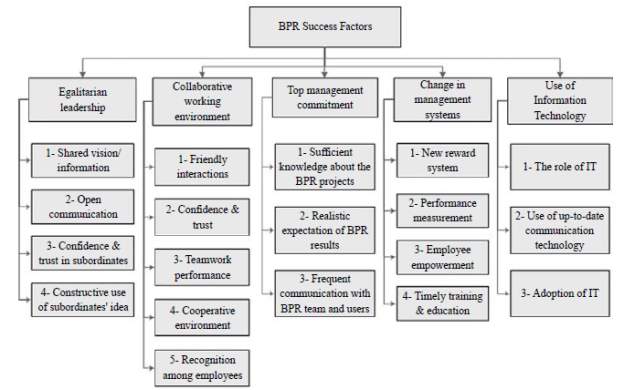
The factor responsible for the failure of the BPR process is identified as “employee resistance” which is basically the resistance to change on the part of levels of the management due to the following reasons
- Resistance by the Middle Management for the fear of losing command/authority.
- Resistance by the employees for the fear of losing jobs.
- Resistance by the employees due to a new working environment.
Evaluation of some of the Critical success factors of the BPR
- Egalitarian Leadership: The top management has a role to play in terms of providing effective leadership by way of driving the changes towards a shared vision. The top management should foster open communication that is vital to decision making in the organization. The top management should involve employees to share their ideas and innovation in the decision making process. Such a involvement would strengthen their faith in the new system and would positively drive them towards the implementation of the BPR.
- Collaborative working environment: Cooperative environment is one of the vital success factors for the BPR implementation.
- Supportive Management: While conducting BPR, the support provided by the management can play a crucial role in transition towards a new working environment. Employees should be encouraged to support the transparent information sharing and a better decision making.
- Information Technology: IT application is a natural ingredient of the BPR project and so its successful application has effectiveness in the success of the BPR project.
A research was conducted which seeks to evaluate the readiness of the Implementation in two companies A and B where the company A saw BPR as way to change its tradition behavior whereas company B saw BPR a solution to improve its performance. Here the measure to assess the readiness was done via a questionnaire approach wherein each question was mapped to a readiness indicator. 770 people in company A received the questionnaire with around 191 people filled the questionnaire out of which 22 questionnaire were discarded owing to a lack of data in them. In company B, 540 people received the questionnaire of which 156 questionnaires were considered to be usable.
Analysis of the survey: The survey was analyzed based on the investigation of 6 indicators. We can see that there are two positive indicators (IN1 and IN5) and one negative indicator (IN6). We can see that the IN3 is having a higher variability than others which tells us that there are many different opinions about the top management commitment (IN3). We can see that company B is better ready for the BPR project and that there is significantly less resistance to change among the employees.
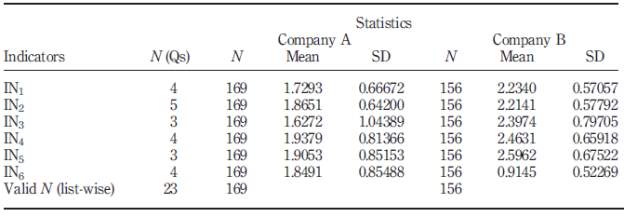
Evaluation of the readiness of the BPR
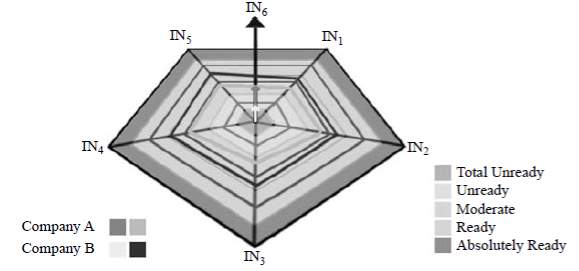
Company’s A result indicates that all its positive and negative indicators lies in the moderate part which indicates that company A is not ready to implement the BPR project. So the top management of the company should strive towards improving the acceptance level of the changes.
Company’s B indicators are near to ready which indicates its low resistance to change and hence it is ready to implement the BPR project.
Implications for the Management
BPR brings a radical change in the three main areas: Human, processes and the technological changes. Having a readiness measure will accurately determine the area which needs improvement for the successful implementation of the BPR and to nullify the risk associated with its failure. There are some measures that can be undertaken on the part of the management in order to improve as follows:
- Management can have a improvement plan strategy so as to let the managers clearly conceive the business processes, the roadblocks in BPR project and how it can be mapped for improvements and the benefits of the BPR.
- To have an egalitarian leadership which makes it possible to have transparency and information sharing, interaction with the employees and increase their confidence.
- Leveraging on the Information technology which is the fulcrum of the BPR project to support the business processes in order to accurately measure the business performance.
- To have measurement systems in place in order to evaluate the process efficiency.
Conclusion
Business Process Reengineering is a significant step towards the improvement of the business processes. Having said that it has a high failure rate associated with its implementation. This research was an attempt to find out BPR readiness based on the analysis of the critical success and failure factors called as the readiness positive and readiness negative. The positive factors like Egalitarian leadership, cooperative working environment, commitment by the top management, and supportive management helps bring about readiness in the implementation of the BPR project. But the resistance to change which is a readiness negative is a hindrance to the successful implementation of the BPR project.
Finally the research conducted the BPR readiness of the two companies A and B. The findings of the research indicated that the company A is not ready and hence it’s high resistance which acts as a roadblock to BPR needs to be countered by a supportive management and technological reform to help the managers focus on the benefits of the BPR. The results of company B indicate a near ready situation. For company A, it is recommended to factor in the changes (supportive management and technological reforms) and then comparing it with the present situation.
Business Process Reengineering: Critical Success Factors in Higher Education
Introduction
Most of the Business process reengineering model fails around 70% although there is increase in quality, decrease in production time and decrease in fixed cost but there is increase in variable costs which leads to decrease in profits. Although if we compare the success percentage of BPR with other organization models it will acquire second spot with 23% success rate only next to technology change with success rate of 28%. Many critical success factors should be considered while developing a model for BPR. In this article we have discussed about various critical success factors and how they should be implemented.
Success Factors for BPR
- Ambitious objectives
- Integration of electronic data processing (EDP)
- The deployment of a creative team in problem solving
- Process approach
- Culture
- Processes
- Structure
- Technology
One study found that companies implementing BPR agreed with their impact their cultural changes are related to their rethinking by the organization Fundamental business processes. Although, the scope and maturity of the business process architecture. The nature of internal changes in processes within the organization also varies. In addition, there significant structural changes have to be made, with particular emphasis on cross-cutting functions Task Force.
One study shows the results of BPR practice in Singapore. The study used a questionnaire that was mailed to respondents using the Data Management Institute’s mailing list. An interesting finding is that about 50% of companies implement BPR, and 30% of companies may also implement BPR in the next three years. BPR is becoming important Singapore in order to survive in the fierce competition and change surroundings. Note and remember the human factor may become interesting Change one of the obstacles that occur. One study also highlighted that human resistance to BPR may lead to unsuccessful BPR projects. If change is not properly handled and managed, people will resist even the top-down approach.
Business Process Reengineering CSFs include change management, management capabilities and support, system architecture, project planning and management, and information technology infrastructure. Effective management of radical change, including communication, is crucial to supporting process change projects and effective leadership in coordinating resource allocation to achieve strategic goals.
In order to determine the CSF of BPR in an organization, it is necessary to understand the organization itself, as the types of these organizations may vary from one organization type to another, including private or public organizations. There are several factors to be considered in the public sector to implement radical changes or BPRs, including a rigid hierarchy, culture, diverse stakeholders, rapid and dramatic changes in policy direction, overlapping initiatives, wide range of activities, Staff boycotts and other public sector organizations is an important part. However, human resources issues should be considered in the public sector. Communication at all levels is one of the key factors. To implement reengineering, an organization needs to understand its structure first and ensure that its vision is achieved. The important point is that communication needs to be maintained and strengthened. Talent issues rather than technical issues are seen as important processes and management to make the change a success. The most important factor in successfully implementing process reengineering in public sector organizations is securing customers.
Cultural issues have been an important factor in the conclusion of BPR by Peppard and Fitzgerald (1997) who examined the transfer of culture-based management techniques such as BPR, with particular reference to the commercial and cultural context in Germany. They analyzed BPR’s business environment for Germany, a business culture that is very different from that of Americans, to prove it. They explored how this American concept can best be transferred to Germany’s business environment. Their research concluded that managers and employees should also assume responsibility for change. In the long run, the conflict-free situation will reflect the success of BPR. Germany emphasizes process and customer focus. Other factors such as autonomy, empowerment, culture and organizational environment appear to be crucial to the successful implementation of BPR in Germany. Six depth levers needed to be changed – roles and responsibilities, measurement and incentives, organizational structure, IT, shared value and skills for successful reengineering. The main issues which underpin a BPR Programme are human factors, scope of change, performance measures, information technology, and business process architecture.
Failure to implement BPR is the manager’s arrogance, resistance, crisis, cost, vision, no process perspective, the fixed process is not flexible enough to meet the needs and requirements, does not involve employees in the decision-making process, Assign a person who does not understand BPR, the technical limitations, design a project but focus on reducing costs, layoffs, weak team, communication difficulties.
One study reported that the lack of financial and human resources, inadequate information technology capacity and expertise is a major issue in the implementation of the business process reorganization plan. Other factors include a lack of support from the members of the organization, a lack of strategic vision, inflexible organizational structure and lack of support for process reengineering. Other factors of failure include a lack of top management support and financial resources, people resistance, IT related issues, inefficiencies in the BPR team, lack of project management and communication issues.
Research methods used for this article were
A) Case study approach B) Open-ended interviews C) Data analysis
Findings and Conclusions
Following factors should be applied in the organizational setting –
Teamwork and quality culture
The evidence here and elsewhere is that organizations should develop a strong and appropriate culture, starting with adopting the core values of the organization, which should be done through a variety of innovative activities. This is because culture has played an important role in the successful implementation of change and avoided the pressure of staff and resistance to change, which is considered as the fundamental obstacle to change. From the survey results it is clear that the emphasis on organizational culture – how teamwork and quality affect BPR. The culture of teamwork will make it easier for the organization to achieve its goals. Therefore, culture should be the top priority of this BPR. It has been suggested that in some cases it may be necessary to change Organizational cultures that ensure fundamental changes of success and competition emphasize the need to change “cultural norms.” Therefore, we think this is the right way to adapt and adopt the right BPR training to ensure its success.
Quality management system and satisfactory rewards
In the organization of work using quality management system (QMS) activities enable organizations to achieve BPR goals. Because QMS itself is so it helps the organization to detect any improvements or changes needed in this process. Another important factor in the compensation system is the practice in the organization should be appropriate for the organizational environment and Suitable for those who can meet the individual staff. A proper organizational system is crucial to the success of BPR. Institutions should include elements of common interest, values and decision-making that demonstrates cultural and structural linkages. For example performance Remuneration promotion and promotion are closely related to employee performance. Compensation system provides a reward, Adjustments and addresses to promote and prepare for change in education Longevity and wage equity issues. Promotions include a “title” change process. For example a scholarly academic may be transferred from the “lecturer” name “Senior Lecturer” title.
Change management
Organizations should have a good understanding of how to manage the impact changes in the organization. Academics is a key, especially in the higher education sector people and important assets management should have a special “art” surroundings. Effective change management should consider the surrounding soft issues Manpower, to avoid changes between staff. Change management involves how managers or leaders manage their potential the impact of change, so that people accept it to implement change. Management change is about managers. Managing change absorbs our knowledge of human beings Incentive, team and leadership. Change management is not about change management. In order to make the radical process a success, people are concerned. Importantly, this is what management should do. Concern for people can make BPR successful.
Project management
Project management is very important for planning and managing the importance of business processes to be implemented. Employees should have sufficient skills to make changes and accomplish tasks that can be gained through appropriate training and education. Therefore, the personal commitment of leaders and managers, as well as employees and team members, is required to achieve the BPR project. Training and education are important long-term benefits, and training and education are crucial when it comes to radical BPR. We agree with this statement. This is an absolutely correct long-term factor. However, it also requires organizing learning methods to share knowledge; if not, it will be meaningless.
Adequate financial resources
Financial resources are obviously important in promoting these initiatives, because without enough funds, no effort will end and become meaningless and stagnant. Therefore, the budgetary allocation to the BPR should be considered as a long-term investment in order to obtain a profit for the organization. BPR involves huge amounts of money. In order for BPR to succeed, organizations need to have enough money to make the change and support unpredictable circumstances or uncertainties. Therefore, proper budget planning for any improvement is very important.
Conclusion
This study provides important lessons as a success condition derived from the results of the case study. The results of this study provide some powerful lessons for organizations that are keen to improve their key processes. Therefore, readers looking for appropriate behaviours and practices in the organization can benefit from the findings. We also emphasize how successful management of change should take into account the perspective of business development. We think the OD approach is appropriate for organizational management change, so it involves a soft system model of change and allows employees to acquire knowledge
Implementation of Business Process Reengineering in Human Resource Management
Processes are the integral part of any production processes. The process is the set of interconnected activities which converts the input into output. Business Process Reengineering is required in today’s businesses to increase the competitiveness and sustain in a world full of uncertainties. BPR has been used in the last two decades as a tool to improve the cost efficiency and service effectiveness. This strategy was first introduced by hammer and champy as a radical approach to reduce fine business process and achieve significant improvements in the business process. Business process reengineering becomes increasingly crucial at a time when most of the businesses are struggling to sustain themselves in the increasing times of competition and economic instability. This paper focuses on improvement in processes of Human Resource Management in an organisation using business process reengineering and supported by lean management tools such as value stream mapping.
Business process reengineering takes enterprise to a totally new level process Management which cannot be achieved by the conventional concept of management. Business process is a collection of activities that takes one or more inputs to create an output. The ultimate aim of the process is value addition. Processes are the steps to achieve the goals of the business. Process can also be defined as structure, set of activities designed to produce a specified output for a particular customer or market.
The concept of Business Process Reengineering was introduced in early 90’s which is a set of ideas, practices and principles which advocate continuous improvement of processes to ensure the productivity and efficiency of the firms. It was seen as a radical method to bring fundamental, quantitative and rapid changes in the business. The main goal of business process re engineering is optimisation of efficiency and effectiveness.
There are four dimensions of business process re engineering:
- Cost Reduction
- Quality improvement
- Increase Production Volume
- Increasing Operations Speed
Various researchers vary on the definition of reengineering, some advocate that it deals with the technological changes to increase economic efficiency. Some believe that it means changing the entire process instead of modifying the existing one.
The creators of Reengineering Hammer and Champi has define free engineering as a fundamental rethinking and radical redesign of business processes in order to achieve dramatic improvements in critical contemporary standards of success such as cost, quality, service and speed. According to the initial advocates of Business Process Reengineering the essence of reengineering is to change the current processes in the organization and not to make the existing processes better . Instead of the modifying existing procedures, Business Process Reengineering tries design and build completely new, inventive processes that require a different approach and completely encompass the key processes in the company
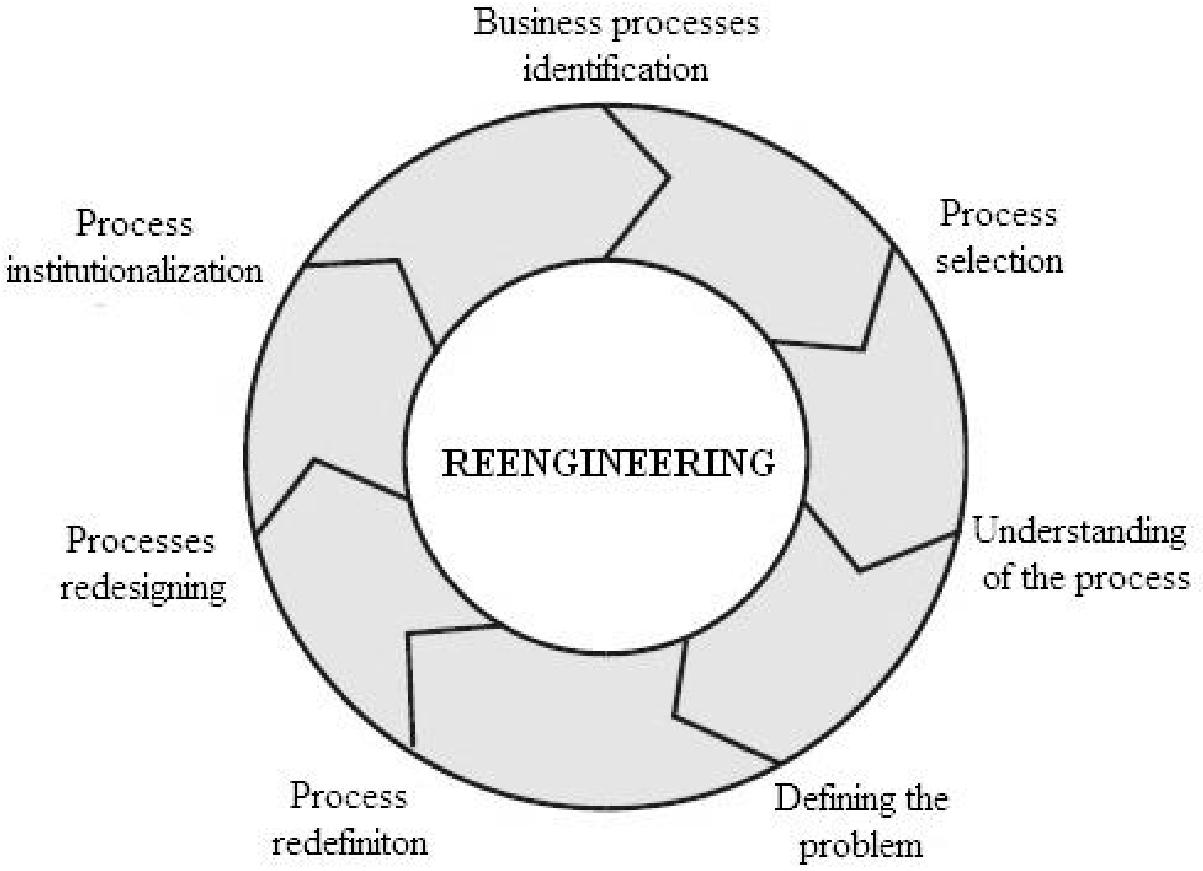
Methodology for implementation of business processes reengineering
Source: (Hammer & Champy, 1993)
Also it should be kept in mind that the subject for reengineering in Business Process Reengineering are the processes and not the organisation or departments. Many times this confusion occurs as to what is to be reengineered and focus shifts to department instead of process.
Human Resource Management
Human Resource Management is one of the most vital components of modern economies which drives the growth of the company. Results of surveys conducted by Watson Wyatt companies in more than 600companies all around the world suggest that good management of human resources results in increase of up to25 % wealth of the company. An efficiently managed human resource provides significant improvements of the operations of companies that are primarily reflected in the increased performance and efficiency of the system as well as the competitive advantage on more and more turbulent market during the time. Employees are also a key factor in Human resource management as they help achieve the organizational goals through dedication and hard work.
Dave Ulrich has given 6 steps of Business Process Reengineering Human Resource management :
- Defining the target process,
- Developing as-in model
- Challenging existing assumptions
- Developing a should-be model
- Implementation
- Measuring business impact
The relationship between business process reengineering (BPR) and human resource management was examined by various researchers. Structure and culture, The role of managers, Team working, and reward system were the four headings under which propositions were analysed. It was found that business process reengineering (BPR) was completely applicable in most of the organizations. Also the need of reengineering in the Human Resource function is ever increasing due to growing inefficiency in HR function of the companies.
Methodology
Harvard Business School suggests six mutually conditioned phases for reengineering of the business processes:
- Planning of reengineering
- Analysis of indentified process
- Redesign of process
- Obtaining resources
- Implementation
- Continuous process improvement
The research was carried out in vertically integrated company to study the process of reengineering of HR. The company deals with exploitation, production, distribution and sale of products and services intended primarily for automotive and aerospace industries. The Company XYZ has been doing business in Serbia for more than 60 years. The company employs more than 8500 employees and has been awarded with many awrds for achievement of quality.
HR process reengineering in the Company
Value Stream Mapping tool(VSM) was used to get more precise insight into the flow of human resources function in the company. Following diagram represents the HR structure of the company before the implementation of BPR.
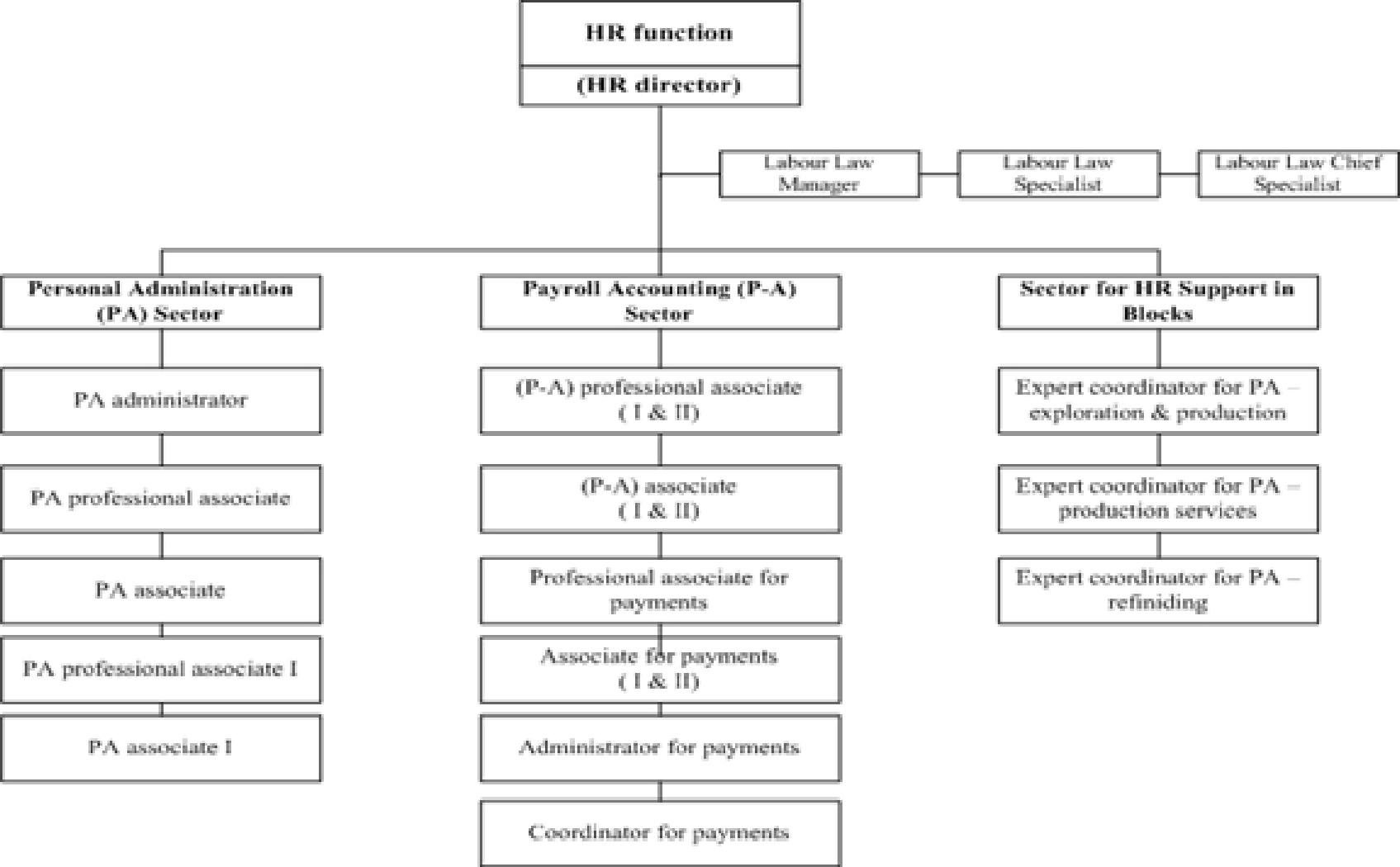
Company’s HR before BPI implementation
Source: Display by the company on the basis of VSM mapping, documents and interviews with HR managers
In the initial stage of analysis the following gaps were identified by sections. In the section for support noticed:
- The control span was narrow,
- There was an unnecessary fragmentation of responsibility between Personnel Administration and HR Services Support in Blocks
- Existence of complicated lines of communicating and reporting
- There was lack of trust towards HR administration
- lines of communications and reporting were inconsistent
- There was no information on workload of each individual employee
- 30 % of administrators are not utilized because of uneven distribution of workload,
- Section for HR Services Support in Blocks is not according to Organization Design Standard in terms of number of employees and span of control,
To improve the performances of the organization it was found necessary to connect all the functions of the company into one integrative line. Also to improve the processes and reduce disadvantages target based performance is advised for HR such as improvement of team spirit and cross-functional communication, better distribution of workload via process optimization, increased quality of work through transparent key performance indicator (KPI) measuring and human capital (HC) optimization as a result of aforementioned.
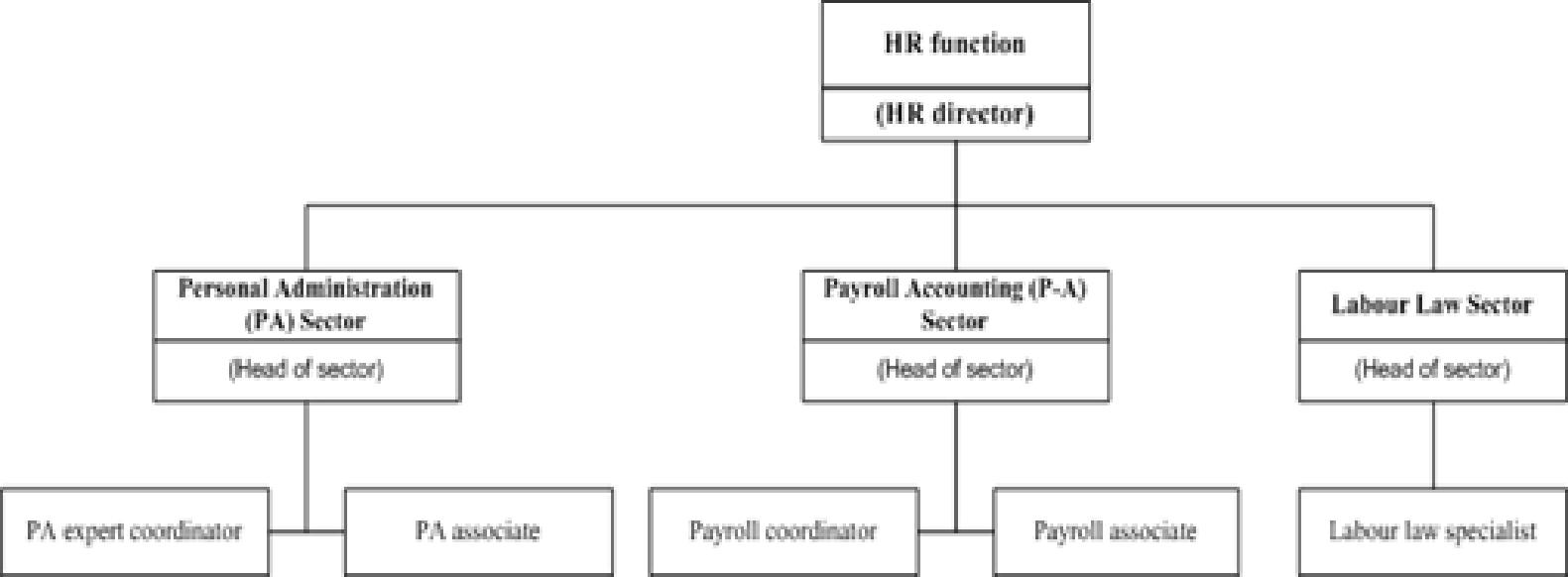
HR process after BPI implementation
Source: Suggestions of the authors for new process
As we can see due to new proposal section for HR services support for blocks was removed. By reviewing the communication lines it was noticed that the director of HR function had a direct communication over a personnel administration by skipping—the HR support and that the final function of support section was confined on administration and on payroll, which was absolutely unnecessary so this section was abolished.
Front-end and back-end division was proposed for Personnel administration division. Back end was for the employees entering data in the SAP, while front end consisted of administrative expert coordinators who dealt with clients..
Similar proposal of Front-End and back-End was made in the payroll section. The role of back-end was same that is entering data in SAP, while front end dealt with employees.
The success of implementation of BPR in Human Resource Management of the company totally depends on its acceptance by the employees. Certain managers at lower levels were resisting the changes made due to BPR because they were looking at it superficially.
References
http://www.bain.com/publications/articles/management-tools-business-process-reengineering.aspx
Davenport, T.H. (1993), Process Innovation: Reengineering Work Through Information Technology, Harvard Business Press, Boston, MA.
Hammer, M. (1990), “Reengineering work: don’t automate, obliterate’’, Harvard Business Review, July-August, pp. 18-25.
https://doi.org/10.1108/14637150810888046
Author: Neda Abdolvand (IT Department, Engineering Faculty, Tarbiat Modares University, Tehran, Iran)
Amir Albadvi (IT Department, Engineering Faculty, Tarbiat Modares University, Tehran, Iran)
Zahra Ferdowsi (IT Department, Engineering Faculty, Tarbiat Modares University, Tehran, Iran)
http://www.bain.com/publications/articles/management-tools-business-process-reengineering.aspx
http://www.bain.com/publications/articles/management-tools-business-process-reengineering.aspx
http://www.linknet1.com/isom210/miscellaneous/examples_of_bpr.htm
https://sopinion8ed.wordpress.com/2012/11/16/a-case-for-bpr/
Cite This Work
To export a reference to this article please select a referencing stye below:
Related Services
View allRelated Content
All TagsContent relating to: "Human Resources"
Human Resources is the aspect of a business that handles employee relations, recruitment, training and other employee elements of the business. An effective Human Resources team can contribute to the successful running of a business.
Related Articles
DMCA / Removal Request
If you are the original writer of this dissertation and no longer wish to have your work published on the UKDiss.com website then please:




